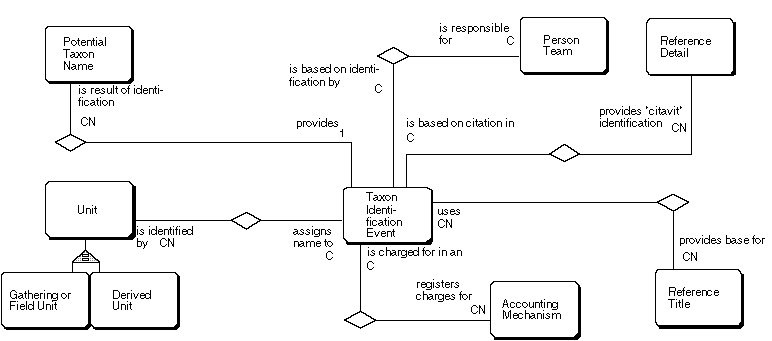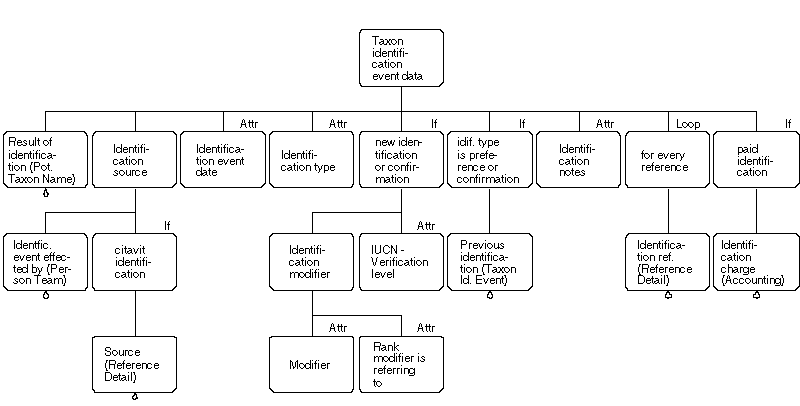
Identifications refer to the unit supertype, because they can
be made on objects in the field as well as objects in a collection.
The result of the identification is a Potential Taxon Name
(Berendsohn 1995) or, where potential
taxa are not implemented, a scientific name, preferably
in standard form (Bisby 1995). The
event is effected by a person or person team at a defined
identification date.
We distinguish several types of taxon identification events (as determined by the attribute identification type):

Diagram 29: Taxon identification (Entities)

Diagram 30: Datastructure of taxon identifications
In new identifications or confirmations, the certitude of the identification may be expressed by a identification modifier. Modifiers include "cf." or "?" with the meaning of "could be", and "aff.", "near", or "c." with the meaning of "is not, but related to, may be new". The rank the modifier refers to must be specified. For example, the modifier "cf." for an identification given as "Abies alba" may refer to genus ("cf. Abies alba"), or species level ("Abies cf. alba"). An additional modification of the degree of confidence that can be placed on the identification is the verification level (ITF standard, IUCN/WWF 1987), which is used to express the degree of authority attributed to the determiner.
If more than one taxon is to be referred to, e.g. in multiple modified identifications ("vel aff." or "vel cf.") or combined new and negative identifications, these have to be treated as separate identifications events carrying the respective modifier and type. Concatenation of such results into a single string has to be handled by the output system (see Meyer & al., this volume).
All units which are linked by derived unit events specifying a "similar" inheritance type form a "similar unit set", which is identified by an attribute in the Unit entity (topmost similar unit pointer). For a specific unit, all identifications referring to a unit in the same similar unit set should be retrieved (see Meyer & al., this volume).
If a unit was involved in more than one identification event, the most recent identification takes preference. Where the date of an original identification is not known, it must be ensured that missing dates are considered older than existing ones.
Identification references (keys, floras, etc.) should be specified by using the link to Reference Titles. In the case that the system refers only to scientific names, citing the major reference relied upon for the determination opens a back-door to later reconstruction of a potential taxon name: The identification reference takes the place of the "sec." citation (circumscription reference) for the potential taxon. Additional notes may be added by the person effecting the identification.
The identification may stem from an annotation of the object (original identification) or it may have been extracted from literature (citavit identification). In the latter case the reference containing the determination is cited.
In culture collections, identifications often carry a charge, especially if requested for commercial purposes. In natural history collections like herbaria this is fortunately (still) a rare exception.